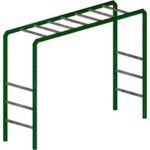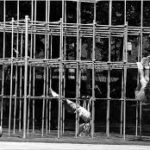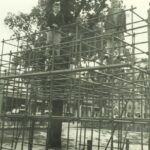
Who among us hasn’t played “follow the leader” on monkey bars? And fallen off with a resounding thud.
While many monkey bars are stand-alone units today, they were originally part of a jungle gym. The first jungle gym was invented in 1920 and patented by Chicago lawyer Sebastian Hinton. While the term "monkey bars" was not used until the 1930s, Hinton's initial 1920 patent cited the "monkey instinct" and advocated the benefits of climbing as exercise and play for children.
Hinton’s father, Charles, a theoretical mathematics professor, struggled to get his students to comprehend the concept of the fourth dimension. One can readily see height, width, and depth, but time?
The elder Hinton reasoned students couldn’t grasp the fourth dimension because they were never exposed to the third dimension as children. He theorized that since we spend so much of our lives simply walking in straight lines, and not using all of the three-dimensional space around us, we have an even harder time making the mental leap to a fourth dimension.
In search of a solution, he built a “game” for his own children, which comprised a series of stacked bamboo cubes, labeling the junctions with X, Y, Z coordinates. The game entailed Hinton calling out “'X2, Y4, Z3 — go!” and his kids racing each other towards the correct coordinate. Not exactly an exciting or fun game, right?
Years later, Hinton's lawyer son Sebastian didn’t remember the math, but held on to fond memories of climbing and swinging on the cubes without regard to coordinates.
The younger Hinton lived in Winnetka, Illinois, a town known for its progressive “whole child” education. This meant not just teaching reading, writing and arithmetic, but also how to be healthy, active humans.
After discussions with the city’s school superintendent, Hinton filed the first of several patents for what he called a JungleGym. In a successive application, he included an 'Accessory monkey runway.'
 His first model still stands today on the grounds of Winnetka’s historical society, though after century it is no longer safe to climb.
His first model still stands today on the grounds of Winnetka’s historical society, though after century it is no longer safe to climb.
Back to my original question: why is the jungle gym — a bunch of metal/wood bars — still so popular 100 years after its introduction? Is it the risk element? That we can use it in so many different ways? Or its appeal to a child’s imagination?
Hinton himself said: "I have designed a climbing apparatus, so proportioned and constructed that it provides a kind of forest top through which a troop of children may play in a manner somewhat similar to that of a troop of monkeys through the treetops in a jungle."